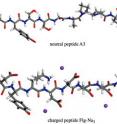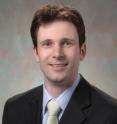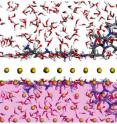Simulations aim to unlock nature's process of biomineralization
A University of Akron researcher is leveraging advanced modeling and simulation techniques to more precisely understand how organic materials bond to inorganic materials, a natural phenomenon that if harnessed, could lead to the design of composite materials and devices for such applications as bone replacement, sensing systems, efficient energy generation and treatment of diseases. Hendrik Heinz, Ph.D., an assistant professor of polymer engineering at UA, is accessing the systems of the Ohio Supercomputer Center (OSC) to study the process of biomineralization, nature's ability to form complex structures, such as bones, teeth and mollusk shells, from peptides.
"Research in our group aims at the understanding of complex interfacial phenomena, particularly biomineralization and organic photovoltaics, at the molecular scale using computer simulation," said Heinz.
"Simulation with atomistic and coarse-grain models and the development of computational tools goes hand in hand with collaborative experimental efforts."
"Advanced materials remains one of the cornerstones of research supported by the Ohio Supercomputer Center and is fundamental to both the economic legacy and future prospects for the State of Ohio," noted Ashok Krishnamurthy. "OSC is committed to providing state-of-the-art computational and storage resources to scientists, such as Dr. Heinz, who are focused on the design of fascinating new classes and applications of materials."
In a recent paper published by Interface, a journal of The Royal Society, Heinz describes how induced charges modify the interaction of proteins, peptides and bond-enhancing surfactants with metal surfaces. In another recent article, published in the Journal of the American Chemical Society, Heinz explains how he used molecular dynamics simulations to investigate molecular interactions involved in the selective binding of several short peptides to the surfaces of gold, palladium and a palladium-gold bimetal.
"Advances in materials science such as in biomedical and energy conversion devices increasingly rely on computational techniques and modeling," Heinz said. "In particular, interfaces at the nanoscale are difficult to characterize experimentally, such as charge transport mechanisms in solar cells, the formation of biominerals, and self-assembly of polymers in multi-component materials. Model building and simulation are critical to understand dynamic processes across the length and time scales."
This summer, Heinz received $430,000 for two years of research funding from the National Science Foundation's prestigious CAREER award program. Heinz and his research team are taking an interdisciplinary approach using concepts from physics, chemistry, biology, polymer science and engineering, as well as computation and statistical mechanics. The grant supports the development of new computational tools to understand biotic-abiotic interactions at the molecular level, as well a team of student researchers, ranging from graduates and undergraduates to high school pupils.
"We have carried out quantitative molecular simulations of inorganic-organic interfaces in excellent agreement with experimental results and developed accurate molecular models for inorganic components," Heinz explained. "These concepts serve as a starting point for understanding biomineralization processes and the performance of hybrid photovoltaic cells, as current examples. Our research efforts aim at complementing experimental results by molecular-level models to intelligently design (bio)molecules, interfaces, and, ultimately, devices."
Source: Ohio Supercomputer Center
Other sources
- Simulations aim to unlock nature's process of biomineralizationfrom Science DailyThu, 9 Dec 2010, 18:31:58 UTC
- Simulations aim to unlock nature's process of biomineralizationfrom PhysorgThu, 9 Dec 2010, 17:02:21 UTC


